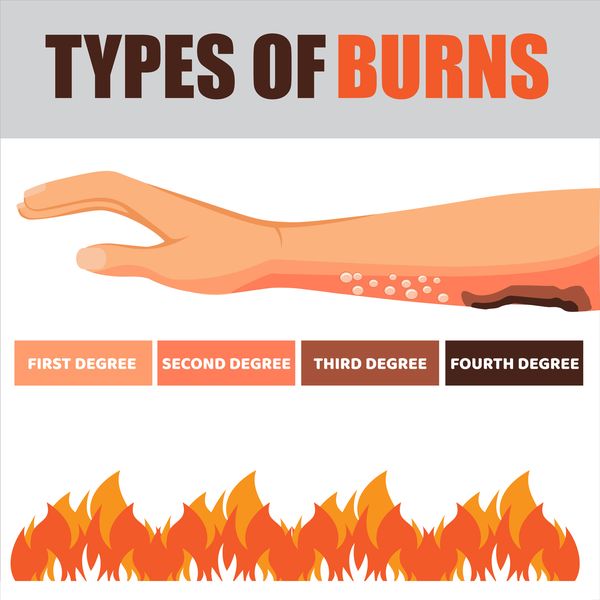Recovering from burn injuries can be long and painful. The risk of infection is high, and many victims require multiple skin grafts. They are also one of the deadliest types of injury.
Whether you suffered burns due to an industrial or workplace accident, car wreck, chemical burns, or electrocution, you could be eligible for compensation from the at-fault party. We can help you.

A Kansas City personal injury lawyer from Langdon & Emison properly values your claim and builds a case for negligence against the party responsible for the event that caused your burn injuries.
Contact us today at (866) 931-2115 for a free consultation with an experienced Kansas City burn injury attorney.
Why do I need a lawyer? Isn’t it enough to visit the doctor?
There are a few key reasons to seek legal advice, even if you’re unsure whether you have a case. First, you may be covered under someone else’s insurance policy. For example, nearly all employers in Kansas City are required to carry workers’ compensation insurance. So, if your burn injury happened on the job, you could be eligible for medical benefits.
Even if you didn’t suffer injury at work, another party’s insurance policy may still cover your medical care and other losses.
Your health insurance carrier may not cover the cost of treatment if another party is liable for the injuries you suffered. They may advise that you seek legal action against the entity or person responsible for the accident.
How can a Langdon & Emison Kansas City burn injury attorney help me?
A Kansas City burn injury lawyer can help you in multiple ways, shouldering the legal burdens so you can heal peacefully.
We investigate to identify all potentially liable parties
Sometimes, a burn injury’s cause (and liable party) is clear. Other times, the responsible party or parties may need more time to determine. We have the resources to thoroughly investigate your accident and list all potentially liable parties in your suit.
We evaluate the full extent of damage, not just physical injury
Burn injuries cause more than just physical damage. They also affect one’s mental health, like post-traumatic stress disorder (PTSD) from the event or depression and anxiety because of changed abilities and altered appearance.
In fact, about one in three burn injury victims develops significant mental distress after the incident.
Your settlement after a burn injury should cover all medically necessary treatments. That may include treating mental health concerns that developed after the accident and burn injury.
We’re prepared to take your case to trial.
Although many burn injury cases are settled out of court in mediation, at Langdon & Emison, we always prepare each case intending to take it to trial. We’re fierce litigators who will strenuously advocate for your interests in the Kansas City civil court.
How much does it cost to hire a burn injury attorney in Kansas City?
The guidance of a skilled burn injury lawyer in Kansas City may be more accessible than you think. Like many others in the city, the personal injury attorneys at Langdon & Emison work on a contingency basis, meaning we only get paid if you do. We charge a percentage of your final settlement or jury award. The legal fee arrangements can be discussed at your first consultation.
What are the 4 types of burns?
Burns are classified by type (how they are caused):
- Thermal burns: Thermal burns are caused by heat sources. The heat source (fire, boiling water, or oil) raises the skin’s temperature, causing blisters, charring, and tissue death. Thermal burns are commonly caused by scalding liquid, hot metal, or flame.
- Chemical burns: Chemical burns are caused by skin or eye contact with harsh substances (either acidic or basic) like detergents, alkalis, acids, or solvents. Chemical burns can occur even with protective equipment, like gloves and goggles.
- Radiation burns: Radiation burns are caused by prolonged exposure to the sun’s ultraviolet rays (deep sunburns) or other radiation sources, like an x-ray.
- Electrical burns: Electrical burns are caused by contact with an electrical current, either direct currents (DC) or alternating currents (AC). These are common on construction sites, where live wires may not be indicated.
4 levels of damage
Burns are classified by severity and the extent of the burn on the body (30% covered, 50% covered, etc.). Burn victims may suffer one level of damage, but more commonly, the affected area may be a mixture of first, second, third, or fourth-degree burns:
First-degree burns
These are mild burns, like a sunburn or a small cooking burn, like touching a hot pan or getting a steam burn. The top layer of skin is red and painful, but the damage doesn’t penetrate beyond the superficial level, and blistering is uncommon.
Second-degree burns.
Both the top layers and lower layers of the dermis (skin) are affected by second-degree burns. Victims experience redness and blistering, swelling, and redness. There may be some scarring and a risk of infection around the blisters.
Third-degree burns.
All three skin layers (epidermis, dermis, and fat) are damaged in third-degree burns. The damage often affects the hair follicles and sweat glands beneath the skin, too, so you may be unable to sweat or regrow hair in the affected area. Third-degree burns also damage the nerve endings, so the pain you feel isn’t at the burn site but rather adjacent to it. Once the burn heals, the skin may look paler than the rest of your skin or white, black, red, or leathery.
Fourth-degree burns.
Fourth-degree burns penetrate all three dermis layers and affect the muscle beneath, sometimes even reaching the bone. Depending on how much of the body is covered in fourth-degree burns, the damage can easily become fatal. Infection risk is higher with these types of burns, and the pain is intense. Many people require specialized burn care for fourth-degree burns and plastic or reconstructive surgery afterward.
Burn injuries require expensive specialized treatment
Multiple studies and research articles note that burn injuries require more specialized treatment than other types of severe injuries and longer hospital stays. Managing infection is paramount; patients may have to be in an intensive care unit until the infection risk is reduced.
There’s also a considerable amount of pain management, especially for victims with third and fourth-degree burns.
Treatment for major burns may include:
- IV fluids to prevent dehydration and organ failure.
- Water-based treatments, like ultrasound mist therapy, stimulate the wound tissue and keep the area clean.
- Ointments and burn creams are applied topically to prevent infection and help the wound close. Silver sulfadiazine (Silvadene) and bacitracin are the most commonly used topicals for second—and third-degree burns.
- Special, sanitary wound dressings to prevent the area from becoming infected and help it heal. In burn centers, the area is usually covered lightly by dry gauze, monitored, and regularly changed by nursing staff.
- Anti-infection medications, likely a round of antibiotics and possibly a tetanus shot
- Anxiety and pain medications. Healing from a serious burn is incredibly painful – many victims say it’s the most intense pain they’ve ever experienced. You may be given morphine or other prescription pain medications, especially during painful dressing changes and medicine application.
These are some of the basic ways to treat burn injuries, although if the covered area is more than 50% of your body or if the burns are mostly third-degree burns, you may require treatment in a specialized burn care facility.
Complications
More serious burns, like third- or fourth-degree burns or those covering more than half of the body, can carry serious complications, like deep scarring, infection, and disability. Complication treatment may happen in a specialized burn center or skilled nursing facility.
More intensive burn treatment can include:
- Intubation (breathing assistance). Sometimes, the throat swells shut if someone is burned around the face or neck area.
- Feeding tube. You may be unable to eat independently, especially if your throat is swollen shut.
- Skin grafts. This procedure involves using your healthy skin to replace scar tissue caused by severe burns. A surgeon will stimulate an area of your body to grow extra skin, then remove that skin and use it to cover the burn areas. Sometimes, skin tissue from pigs or a deceased skin donor may be used.
- Easing blood flow. Sometimes, the burn eschar (scab) goes completely around a limb and tightens, which reduces or ceases the blood flow to the affected area. For example, if the eschar goes completely around your chest or rib cage, you may have trouble breathing. Or, if it’s around an arm or leg, the tissue below the eschar may necrotize due to loss of blood flow. A doctor can cut the eschar and relieve the pressure.
- Reconstructive or plastic surgery. This can help reduce the appearance of burn scars, increase the flexibility of affected joints, and correct physical damage to the face, ears, fingers, and toes.
What are the common causes of burn injuries in Kansas City?
Some of the most common causes of burn injuries include:
- Fires
- Electrocution or a live wire
- Exposure to radiation
- Severe sunburn
- Exposure to hazardous chemicals
- Cooking
- Coming into contact with steam
How can we help you prove liability for a burn injury?
Your burn injury attorney in Kansas City must prove that the at-fault party is legally liable for your injuries. This means establishing that the person or entity was negligent and abandoned their duty of care for your safety. For instance, we gather evidence proving that the defendant failed to adhere to safety standards for handling a live wire or didn’t drive responsibly.
From there, we build a case showing that the defendant had a duty of care for the safety of others and abandoned that duty, causing the accident directly or creating conditions where an injury was likely.
Did you or a loved one suffer a burn injury? Langdon & Emison can help.
We know that the road to recovery after a burn injury is often long and hard. You may be permanently scarred and disfigured or not have the same abilities as you had before. The cost of treatment, including skin grafts, can easily reach tens of thousands of dollars.
A proper settlement from the at-fault party can cover the cost of these extensive treatments and provide a means to support your family while you’re out of work.
We can help you demand full and fair compensation. Call Langdon & Emison today at (866) 931-2115 for a complimentary case review with one of our Kansas City burn injury attorneys.




